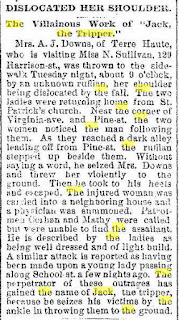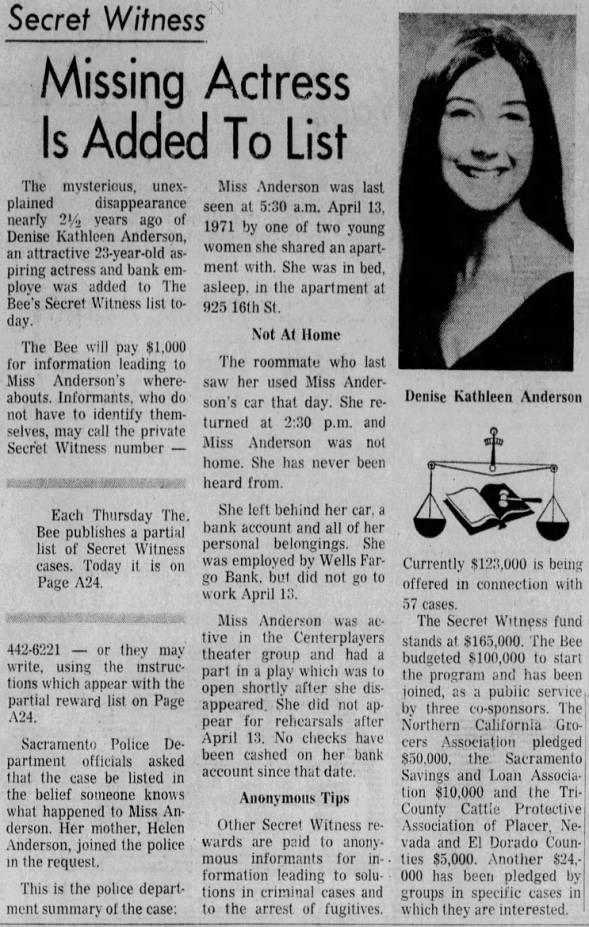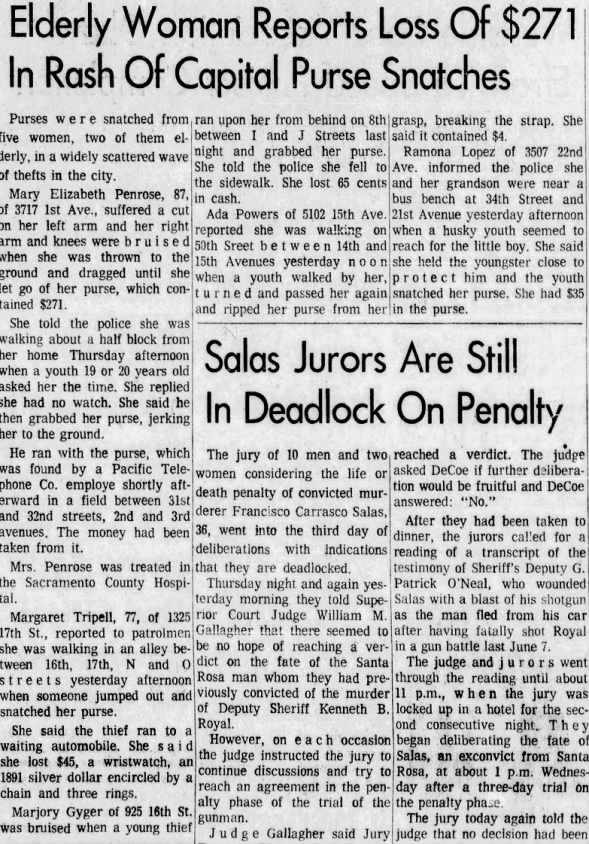Author: Shane Lambert
Original Time of Writing: February 2017
Major update: December 25th, 2020
All articles are subject to editing after the original posting.
Missing Person: Denise Kathleen Anderson
Last seen or contact date: April 13th, 1971 at 530am
Where last seen: Last seen in Sacramento at her apartment by one of her two roommates. The address was 925 - 16th street. Denise was sleeping in her bed at 530am.
Ethnicity/Race: White
Sex: Female
Age at time of disappearance: 22 years old
Hair: Brown
Eye color: Brown
Height and weight at the time of disappearance: Straight, longer than shoulder length
Clothing: A wig was missing from her apartment. Black. Short-hair style.
Denise Kathleen Anderson has been missing since 1971. Her disappearance is perplexing. The last anyone saw of her was 530am on April 13th, 1971. At that time, it seems that she was sleeping. The person that saw her was a female roommate, one that borrowed Denise's car that day and returned it at 230pm. Denis was gone at that point, not yet to be seen again.
Denise had two jobs: one at a bank (a Wells Fargo Branch) and one as an actress at the Centerplayers theatre group. She did not show up for her work at the bank on April 13th, nor did she appear at other future rehearsals for the play that was opening.
Denise Kathleen Anderson Thu, Sep 6, 1973 – 3 · The Sacramento Bee (Sacramento, California) · Newspapers.com
I originally covered this case in 2017. At that time, I remember feeling dismayed that there wasn't much media coverage from the time of the disappearance.
However, in taking a fresh look at this case, I feel that there is one lead that needs to be investigated. Whether it has been or not is not something that I do not know. My opinion is that the Visalia Ransacker, also known as the East Area Rapist, also known as the Original Night Stalker, and also known as Joseph James DeAngelo should be considered a person of interest in this case.
In the article below, please note the address at the bottom of the left-hand-side column. It is the same as Denise Kathleen Anderson's address from the article above. I think there are significant implications.
Denise Kathleen Anderson Sat, Oct 19, 1968 – 5 · The Sacramento Bee (Sacramento, California) · Newspapers.comAs per the article embedded above, in late 1968, there was a rash of burglaries in Sacramento. One woman among the many victims, Marjory Gyger, was robbed of her purse. This woman's robbery is important because she lived at 925 16th street in what I assume to be Sacramento because the robberies were reported in The Sacramento Bee on October 16th, 1968.
The building at 925 16th street was an apartment. That can be ascertained from Denise's missing person's report. It can also be ascertained from classified ads that I read about the address. That means there would be more than one unit number and that's a point to take away. However, I still can't ignore that a robbery victim may have been of the same address as Denise, albeit 2.5 years earlier. It's shocking that they should post a victim's address but, that aside, it brings up three questions.
- When Marjory Gyger was robbed of her purse, did she lose her house keys in the purse?
- If she did, then were the locks ever changed?
- Was Marjory Gyger's unit number in the apartment the same as Denise's (ie. maybe Denise and her roommates were the next tenants)?
If the respective answers to those questions are "yes" and "no" and "yes" then a probability arises that a problem youth who was committing rampant robberies had the keys to Denise Kathleen Anderson's apartment. These are questions I invite websleuths or amateurs to help answer with whatever databases they have memberships for.
How did this problem youth get the address for the keys? One source would be any identification in the purse, however, there's an elephant in the room -- he could simply have got it from the newspaper coverage of the robberies.
The gap of 2.5 years between the street robbery and the disappearance of Denise Kathleen Anderson is, perhaps, unexpected. However, I don't feel it speaks too strongly to an unlikelihood of a connection between the two events.
When it comes to a connection to the Original Night Stalker, we all know he was the Visalia Ransacker between 1973 and 1976. That shows that he had a propensity for theft. Furthermore, his Wikipedia page delivers three key points:
- It says that in August of 1968 he was in Rocklin, about 30 minutes away from Sacramento. It says he was a student at Sierra College which would bind him to the greater-Sacramento area for at least a semester and it would place him within a short drive of the robberies.
- He attended Sacramento State University in 1971. Going by the modern Google Maps, the address of "925 16th street" and that university is just an 11-minute drive. I don't know what it would have been in 1971.
- His profile on Wikipedia says that he committed robberies as a teenager. While he was not a teen in 1968, that knowledge of him shows that he did not get his criminal start as the Visalia Ransacker.
A major point to take away is that Joseph James DeAngelo was in the area, both at the time of the robberies and at the time of Denise's disappearance. His convictions and reputation speak for themselves on other matters: this is, without any doubt following his 2020 convictions, a person that would be capable of entering someone's home with sinister intentions and disappearing a woman. If he was the "husky youth" that committed the robberies and if he got keys to an apartment that he knew the address of, then him attempting to enter that apartment would be a matter of course.
That the points I've made are circumstantial is not something I'll apologize for. I'm a guy with the Internet and a willingness to get database memberships to expand the Internet's searching power.
But I am only arguing that he's a person of interest, not that he did it. If he is not the person that committed the robberies, then whoever is that person would still be a person of interest. However, I do note a similar description: DeAngelo was a husky guy, just like the one described in the robbery article. Furthermore, I think DeAngelo was pretty smart and, if he was to visit the apartment, then he wouldn't do it until lots of time had passed.
Lastly, there is a cleverness to the purse snatchings that I think you see in DeAngelo's known crimes. The purse snatcher head-faked a woman: he reached for the woman's child and then when she guarded that child, he grabbed her purse. There's a clever modus operandi there, albeit of the evil kind. I always felt like DeAngelo was an intelligent guy with a craftiness that you don't see in many criminals.
That brings us to the conclusion of this article and a hypothetical scenario that I invite the reader to not just consider but to attempt to refute.
The scenario starts with a rash of robberies in Sacramento in 1968, robberies that involved purse snatching. What if that purse snatcher was Joseph James DeAngelo? We all can agree that purse snatchings yield more than money -- they yield identification and keys. One of the victims of the purse snatchings was a woman who had an address that was the same as Denise Kathleen Anderson's, at least as far as the street address went.
What if they shared the same unit number in the apartment? Would that not potentially put Denise's apartment keys in the hands of a very dangerous man? If the locks weren't changed, then that's what it would do.
And then what would we have? Maybe DeAngelo plans to rob the place. He thinks the apartment is empty because her car is gone -- the roommate used it that day. So he enters the apartment thinking that he is home free for a pre-Visalia ransacking -- only to find that Denise is home. Now, he has to deal with her and that involves disappearing her.
A refutation of this scenario would include evidence that Gyger had a different unit number than Denise. Also, maybe she never lost her keys. Then again, we know DeAngelo liked to visit his victims sometimes. The way he phoned one woman spoke to that. If he just had the address and not the keys, things come into play still.
If the locks were changed, then that's a punch in the stomach as well. How someone might find that out, I don't know at this point. Work orders for 1968 to 1971 lock changes probably aren't easy to come by.
If DeAngelo can be shown to be somewhere else at a critical time then that's a blow as well. However, it would still leave open the possibility of another person of interest.
But, in conclusion, when DeAngelo committed his crimes, he wasn't just the one-and-done type. As the Visalia Ransacker, he committed many linked crimes. As the Original Night Stalker, he committed many linked murders. He also had scores of linked rapes. That there was a rash of purse burglaries that were seemingly linked together in journalism kind of fits a young DeAngelo.
Also, we're talking about a beautiful missing woman from Sacramento. DeAngelo's name should come to mind just like Ted Bundy's should if we're talking about the same kind of missing person in Seattle.
Same-name hits
- Be careful when doing research. There is a Denise Kathleen Anderson that's born in the same county that is NOT the missing person. She, the wrong DKA, was born in 1952.




.jpg)
.jpg)




.jpg)
.jpg)

.jpg)



